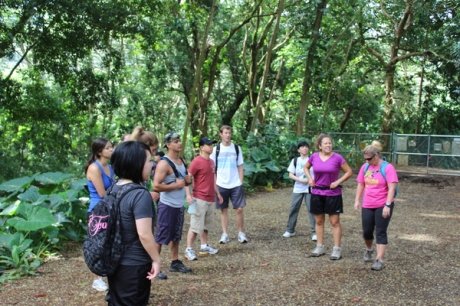Not far from the iconic University of Hawaii and Downtown Honolulu lies the tropical jungles and lush vegetation of Manoa Valley, a paradise of forest and falls that pulls at the average adventurer to follow its course and leads many to explore more of this great island. Due to its popularity as the film locations for such blockbusters as Jurassic Park and LOST, as well as aid from the Japanese tourism industry, boosted this site to most visited trail by more people than anywhere else on Oahu. How does one maintain a highly-visited 0.9-mile trail in the middle of the forest and its 180-ft waterfall?
Restoration efforts include University of Hawaii’s Lyon Arboretum reforestation projects high above to Pauoa Flats and the Sierra Club Hawaii Chapter’s Restore Manoa Project utilizing various rock laying techniques to filter the seasonal rains across the trails and not corroding this beautiful place with its high traffic. Sugar and bamboo cane grows full and large in the back of the valley as part of a 1940’s experiment to introduce a plantation and fields for expanding crops. Plant life remains diverse among the farther reaches for the resolution of the plantation and introduction of the University of Hawaii botanical influences to the valley. While on the top of flora worth mentioning is the large banyan tree in the parking lot and its legend as a paranormal connection to Hawaii’s Night Marchers, a group of dead warriors who bring bad omen to those who come face-to-face with them. Best to play dead as the story goes or else become one.
Seasons are important to Hawaii amidst criticism that we on Hawaii only have the year-long summer. Temperatures range from 68 in the winter to 87 and above during hot summer months. Rainfall is a necessity to the tropical rain forests and the trade winds will bring an abundance each year listing a 300 inches over one season in Oahu’s Kahana Valley, a mere ten miles away. Manoa Falls in the winter months find this trail bathed in pools of red mud, filled with mosquitos, and flooded with rivers at full strength. Summer months give way to dry mud paths and worn rock surfaces making navigating the trail easy on pets, kids, and the elderly. Be mindful as a quick storm can give way to those dangerous trail conditions mentioned above.

Barefoot Hikers assembled right inside the Manoa Falls Park fence at the end of the Manoa service road.
So where do I begin my adventure, you ask? Manoa Falls is located on Manoa Road at 3131 Manoa Rd. This location is at the very back of the valley. Located at the entrance is a parking spot charging upwards of five dollars for a single teenage or college-aged student to act as security guard and watching the area. This is an option due to high theft at a lot of Hawaiian tourist spots; this being no exception. The other arrangement is to park in the lower neighborhood and walk the half-mile to the parking lot and another quarter mile up the fire lane service road to the fenced entrance to the park. There is no fee to hike. More directions can be found at this site. As always mentioned on these blogs, DO NOT LEAVE VALUABLES IN YOUR CAR.
This hike will take roughly an hour in, one hour back. Humidity and wet conditions could pose breathing difficulty as well as pollen. High pollen seasons include March through November on the island. Shoes are encouraged. Have fun and don’t forget to share your adventure with all of us!
References


